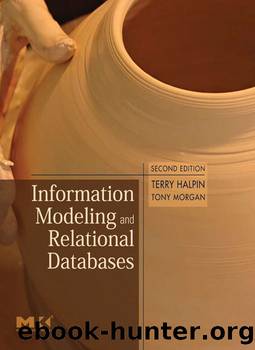Information Modeling and Relational Databases by Terry Halpin

Author:Terry Halpin [Halpin, Terry; Morgan, Tony]
Language: eng
Format: epub
ISBN: 978-0-08-056873-7
Publisher: Elsevier Science
Published: 2008-11-14T16:00:00+00:00
Figure 10.62 The categorization relationship âis of:â.
For the first-order logic interpretation, all types are first-order, so instances of B are individuals, not types. We use lowercase letters (possibly subscripted) to range over individuals. For our higher-order logic interpretation, we use capital letters (in italics) to denote type variables of any order. The order (1, 2, 3, â¦) of any type is implicit, since it can be derived by inspecting the full schema. If it is desired to explicitly show the order of a type, a presuperscript may be used (e.g.,2B indicates that B is a second-order type).
Post-superscripts are typically used to denote arity, and postsubscripts are often used to distinguish variables of the same type. Ignoring the case of crossing metalevels, assign the order of a type to be 1, plus the number of relationships in a contiguous chain of zero or more categorization relationships that end at the type.
Using â1 for the âthere exists exactly oneâ quantifier, we may now formalize the constraints on the categorization relationship in Figure 10.62(b), which has a mandatory and uniqueness constraint. The first-order formalization treats AccountType as a type of individuals.
Download
This site does not store any files on its server. We only index and link to content provided by other sites. Please contact the content providers to delete copyright contents if any and email us, we'll remove relevant links or contents immediately.
Algorithms of the Intelligent Web by Haralambos Marmanis;Dmitry Babenko(16234)
Azure Data and AI Architect Handbook by Olivier Mertens & Breght Van Baelen(7674)
Building Statistical Models in Python by Huy Hoang Nguyen & Paul N Adams & Stuart J Miller(7655)
Serverless Machine Learning with Amazon Redshift ML by Debu Panda & Phil Bates & Bhanu Pittampally & Sumeet Joshi(7529)
Driving Data Quality with Data Contracts by Andrew Jones(7292)
Data Wrangling on AWS by Navnit Shukla | Sankar M | Sam Palani(7290)
Machine Learning Model Serving Patterns and Best Practices by Md Johirul Islam(7029)
Learning SQL by Alan Beaulieu(6237)
Weapons of Math Destruction by Cathy O'Neil(6214)
Big Data Analysis with Python by Ivan Marin(5933)
Data Engineering with dbt by Roberto Zagni(4931)
Solidity Programming Essentials by Ritesh Modi(4565)
Time Series Analysis with Python Cookbook by Tarek A. Atwan(4399)
Pandas Cookbook by Theodore Petrou(4086)
Blockchain Basics by Daniel Drescher(3540)
Natural Language Processing with Java Cookbook by Richard M. Reese(3143)
Hands-On Machine Learning for Algorithmic Trading by Stefan Jansen(3042)
Learn T-SQL Querying by Pam Lahoud & Pedro Lopes(2929)
Feature Store for Machine Learning by Jayanth Kumar M J(2925)
